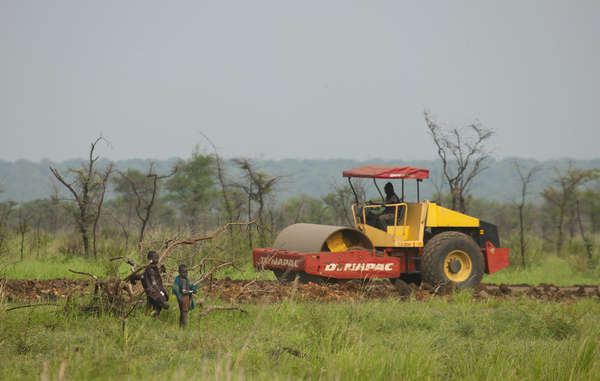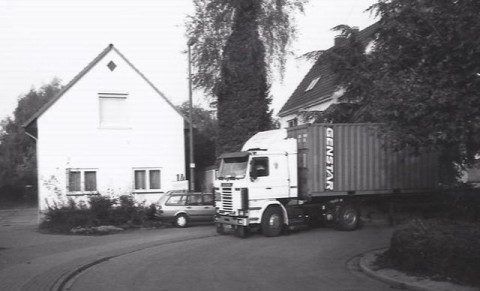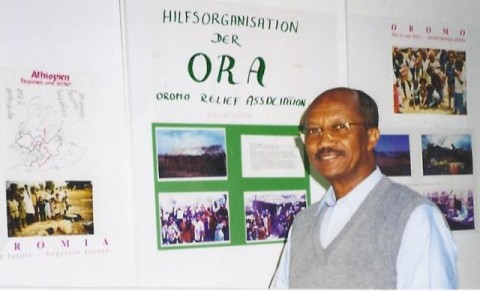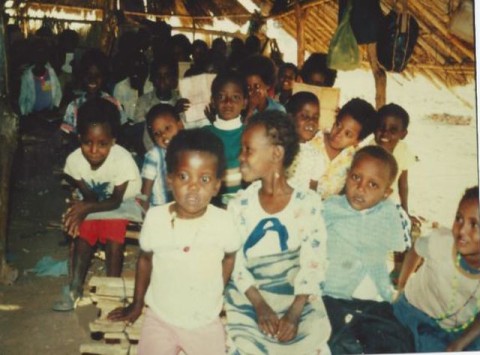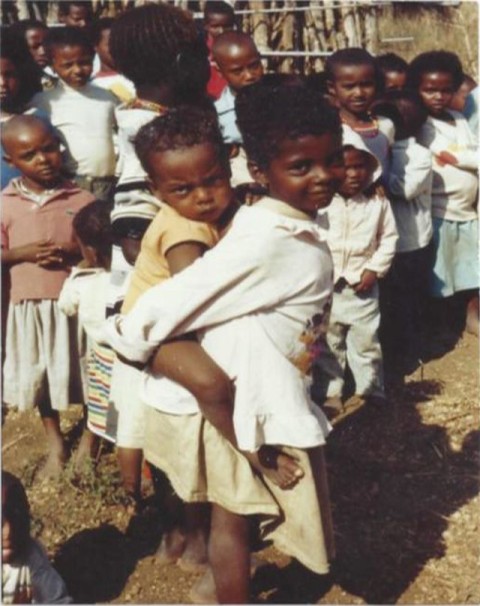By Mekuria Bulcha (Prof.)
“… many of us lost our parents and relatives and were cared for by the Oromo Relief Association (ORA) for our survival and wellbeing. With the support of the international community and Oromos abroad, some 1,700 of us have been taken care of in exile in the Blue Nile Province of the Sudan … The ORA gave us the chance to survive” (from a letter by “Raagaa,” one of the ORA children 1993).
“The lives of those of us who did not experience the sweet love of parents, but had known only an organization [ORA] were devastated when the organization collapsed; we were left alone without relations. There are many who shared my misfortune; regrettably the whereabouts of many of them remains a mystery” (from an interview by the author with another former ORA child, Leensaa, March 2014).
“We appeal to you to do all you can to shed light upon the fate of the more than 1,600 children from ORA camp in Kobor. Where are Sagantaa Useen, Tolina Waaqjiraa and Duulaa Tafarra and all others?” (from a letter sent by the teachers and pupils of Heinrich-Goebel-Realschule to Dr. Klaus Kinkel, German Minister of Foreign Affairs, November 2, 1992)
Introduction
The three quotations presented above are from documents used in writing this article and reflect, in one way or another, the fate of about 1,700 Oromo children who were looked after by the Oromo Relief Association (ORA) in the refugee camps of Yabus, Damazin and Bikoree in the late 1980s. The first quote is from a letter written by one of the ORA children to the ORA office in Germany after he had escaped from the Dhidheessa concentration camp in 1993. “Ragaa” is a fictive name as the letter’s writer lives in Ethiopia. The second quote is from an interview with Leensa Getaachoo who was one of the ORA orphans. First incarcerated at the age of ten in 1994, she had been in seven Ethiopian prisons before she fled from Ethiopia in 2000. A brief account of her more than a decade-long odyssey across three continents and her sojourn in six countries in search of a safe haven is included in the last section of this article. The last quotation is from a letter written by students and teachers of a school in Germany appealing to the German Ministry of Foreign Affairs to help them find out the whereabouts of the ORA orphans. Their school supported the ORA project materially and the pupils were pen friends with the ORA children.
The main purpose of this article is to shed light on what happened to the ORA children in western Oromia during the summer months of 1992. Associating them with the Oromo Liberation (OLF), the Tigrayan Liberation Front (TPLF) imprisoned hundreds of them in 1992 and 1993 along with thousands of Oromo civilians and OLF fighters in the Dhidheessa concentration camp. Although I knew that many of the ORA children were imprisoned, I only got a hint of the full magnitude of the crime committed against them last year when I came across a report written in 1996 by the UK based Oromia Support Group (OSG Press Release, No. 13, 1996). The OSG wrote about the flight of the ORA children and their guardians chased by the TPLF forces. The report noted that “After three weeks on the run, with rain, mud, hunger and sleeping rough in the bush, the remaining 600 or so children were attacked in the Gunfi area … Local informants claim that the fleeing children were hunted like kurupé, a small antelope which leaps to see its way while fleeing through tall vegetation.” (Emphasis mine) This reminded me of what I read about the now extinct indigenous inhabitants of the island of Tasmania. They were hunted and killed by white settlers just like wild game and were exterminated. It is embarrassing that we have failed to record the story of the ORA children properly during the last twenty-two years. However, I believe that it is our obligation to record their story now and bring it to the attention of particularly the Oromo people. As the first two quotations above indicate, most of the children were parentless; the majority had no families to remember them. It is our duty to remember them by recording their story.
An inquiry into the intention of the crime is another aim of the article. The crime was carried out systematically and over a long period of time. The question is: why? Why did the TPLF forces chase children and adolescents for over three months and capture or kill them, when they knew that they were unarmed youth and that the adults accompanying them were not fighters but their guardians? Based on information gathered through interviews and the description of the manner in which the TPLF security forces have treated them inside and outside the concentration camps, the article will argue that politicide,[i] was perpetrated against the ORA orphans. The TPLF was in an open war with the OLF when the children were massacred in the summer months of 1992. Consequently, it wouldn’t be farfetched to argue, as I will do in this article, that the atrocities committed by the TPLF against the ORA children and their guardians constitute a war crime.
Thirdly, the article will show that the persecution of the ORA children was a springboard for the TPLF policy of liquidating those individuals and groups its makers see as bearers of the seeds of Oromo nationalism, and that this has culminated in the current widespread war against Oromo students. I will describe, albeit briefly, the case of other Oromo children and youth who have been accused of “supporting” the OLF or branded as “terrorists” and treated with incredible cruelty. The many crackdowns on Oromo students during the past fifteen years, including the ongoing war against secondary school and university students throughout Oromia, which I will discuss in another forthcoming article, are guided by the same odious policy which led to the massacre and imprisonment of the ORA orphans. Based on my readings of its cruel treatment of the educated Oromo youth, my assessment of the main objective of the TPLF regime’s policy has been to deprive the Oromo nation of its current and future leaders. In short, what has been going on in Oromia since 1992 is clearly politicide. Oppressive Latin American dictatorships, which were led by military generals, such Augusto Pinochet in Chile from 1973 to 1999, and Jorge Rafael Videla, Leopoldo Galtieri and others in Argentina between 1975 and 1983, used politicide to liquidate their opponents. Although not widely known and acknowledged, the politicide carried out against Oromo intellectuals, businessmen and students — who are often labelled by the TPLF regime as “OLF supporters” or “terrorists” — surpasses in its ferocity that of the Latin American dictators against the so-called communists. The TPLF regime’s treatment of its Oromo victims is in many ways “dirtier” than the “Dirty Wars” which the Argentinian military dictators carried out against left wing politicians and others between 1975 and 1983. Politicide takes on genocidal characteristics when carried out against members of an ethnic, linguistic or “racial” community. The policy of the Tigrayan ruling elites against the Oromo displays these characteristics.
Sources of information
The article is based on information collected from both primary and secondary sources. The primary sources comprise:
a. correspondence which I had with a former teacher and head of the ORA children’s project – who was also with the children during their flight from the TPLF in western Oromia,
b. written and telephone interviews with two former ORA children who live in an African country and one who lives in England,
c. telephone interviews conducted with Oromos who were imprisoned by the Ethiopian regime in the 1990s. These Oromos, who are now scattered across different countries in Africa, North America and Europe and who know what happened to the children during the second half of 1992 or later.
I have consulted reports and documents from the archives of ORA as a secondary source of information. These include a short letter written inAfaan Oromoo by one of the ORA children who were deported to the Dhidheessa concentration camp in June 1992. He escaped from the concentration camp in 1993 and found his way to Finfinnee (Addis Ababa) from where he wrote the letter to the ORA office in Germany. The letter was translated into English by Tarfa Dibaba. The other secondary source of information, an OSG (Oromia Support Group) report, was based on interviews with the surviving children, teachers, guardians and local Oromo population of western Oromia in 1996. The third document used here is a short article based on an interview given in 1994 by a former prisoner of the Dhidheessa concentration camp. The interview was in Afaan Oromooand was translated to English by Yoseph Taera & Kathrin Schmitt and published as “An EPRDF Prison Camp from Inside” (see Oromo Commentary, Vol. VI (1), 1994). The informant was a detainee at the Dhidheessa concentration camp. Other documents obtained from the ORA archives in Germany include most of the photos used in the article, and a copy of the letter written by the teachers and pupils of Heinrich-Gobel-Realschule of the city of Springe in Germany to the German Minister for Foreign Affairs in November 1992 mentioned above. The article has three short parts, including this one. The second part will discuss imprisonment and death in the Dhidheessa concentration camp. The third part consists of short life stories of some of the children, both dead and alive.
The Oromo Relief Association: Its Origins and Objectives
The Oromo Relief Association (ORA) had its origin in a clandestine committee created during the dark days of the so-called Red Terror, which was unleashed by the Dergue (the Ethiopian Military Regime) and devoured thousands of the educated youth in Ethiopia in 1977-78. The objective of the committee was to assist families whose breadwinners were jailed, had “disappeared” or had been killed. The committee was known as “Funding-raising Committee,” and functioned mainly in Finfinnee (Addis Ababa). Oromo government employees and businessmen made contributions to assist the work of the clandestine committee.[ii]
When it was formally established abroad in 1979, one of the objectives of ORA was to assist in bringing up the children of those Oromos who had died or were imprisoned because of their role in the national struggle for freedom. ORA provided humanitarian assistance to needy people in the OLF-held areas, and offered medical and social service for Oromo refugees in the neighboring countries of the Horn of Africa. The Sudan was one of the countries in which the association was established and was recognized by its government.
ORA’s humanitarian activities in the Sudan
I visited the ORA offices in both Khartoum and Damazin in the Sudan for the first time in November 1981. From December 1982 to February 1983, I was again in the Sudan and could see the progress which the association was making in providing crucially needed services to Oromo refugee communities settled in the Blue Nile Province of the Sudan. In all the places I visited in the Sudan, the largest concentration of Oromo refugees was in Yabus, a district located south of Kurmuk town near the Ethiopian border. Being one of the remotest districts in the Sudan, Yabus lacked not only a clinic and a school, but also all means of communication, including roads. In February 1983, I presented a report entitled “Some Notes on the Conditions of Oromo, Berta and other Refugees in the Kurmuk District of the Blue Nile Province, Republic of Sudan” (Bulcha, 1983) to the UNHCR and NGOs in Khartoum, to raise awareness about the problems which were facing Oromo refugees in the remote districts of Sudan’s Blue Nile Province, particularly the health problems and high death rate among children. I also pointed out that the only organization which was assisting the refugees in the province was the ORA, and that it had almost no resources at its disposal to support even its staff. The UNHCR and NGOs responded positively to my short report.
Picture 1: The head of ORA, Fakadu Waaqjiraa in the ORA office in Khartoum, Sudan
Photo: Mekuria Bulcha, November 1981
The UNHCR sent a staff member to Damazin and followed up the problem. Among NGOs was Médecins Sans Frontières (MSF) or Doctors Without Borders, which participated in providing medical service to Oromo refugees and the ORA children whose stories are given in this article. Researchers from Europe and the U.S. were also in the region and to conduct further studies of the problem facing Oromo refugees.[iii] The report was also presented during workshops organized by ORA support committees in some European countries.
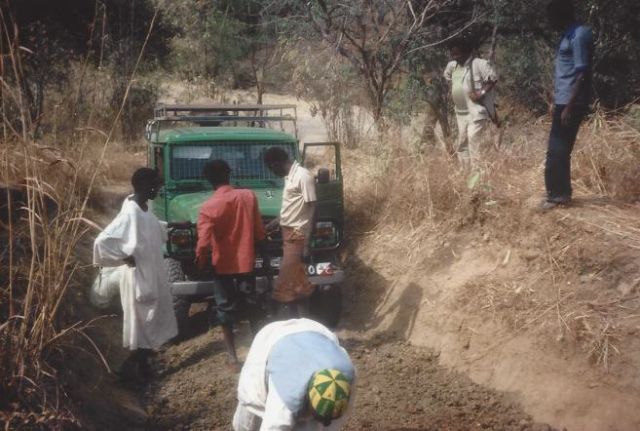
Picture 2: On the Road from Yabus to Darsumma near the Ethiopian boarder in 1983; Yabus was inaccessible by vehicle during the rainy season and barely accessible even during the dry season.
The Toyota Land Cruiser was a donation from the ORA Support Committee in Holland and was fitted with spare parts for the rough terrain. The person standing farthest from the camera is the late ‘Goota Bobbaas’ Bunee (d.1991), veteran of both the Maccaa Tuulama Association and the OLF.
Photo: Mekuria Bulcha, February 1983
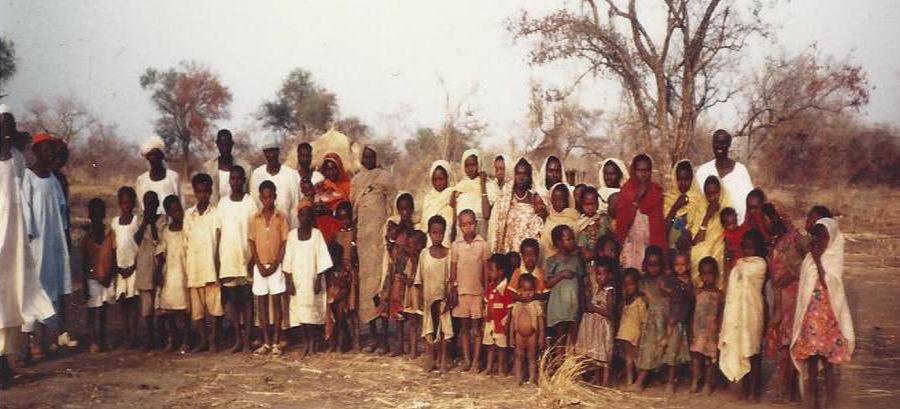
Picture 3: a group of Oromo refugees in Yabus in 1983. Stranded in the middle of nowhere in inaccessible border areas, hundreds of Oromo refugees were suffering from hunger and diseases when I visited Yabus in 1983. Malaria and diarrheal diseases were taking their toll particularly among the children.
Photo: Mekuria Bulcha, February 1983
Through hard work and assistance from Oromo Support Committees in Europe and the U.S., the ORA was able assist Oromo refugees in the Horn of Africa, particularly in the Sudan. Through its children’s program, the association provided education to young refugees, and took care of parentless children in shelters it had built in the Sudan (see Tarfa Dibaaba’s book: It is a Long Way: A Reflection on the History of the Oromo Relief Association(2011)).
Picture 4a (Above Left): Tarfa Dibaba, former head of ORA office in Germany and coordinator of ORA activities abroad at a school event in Oldenburg, Germany, talking about ORA and its activities; Picture 4b (Right): Relief shipments with clothing, school material, toys, sports equipment and musical instruments for the ORA children in the Sudan arriving at the ORA office in Delmenhost, Germany.
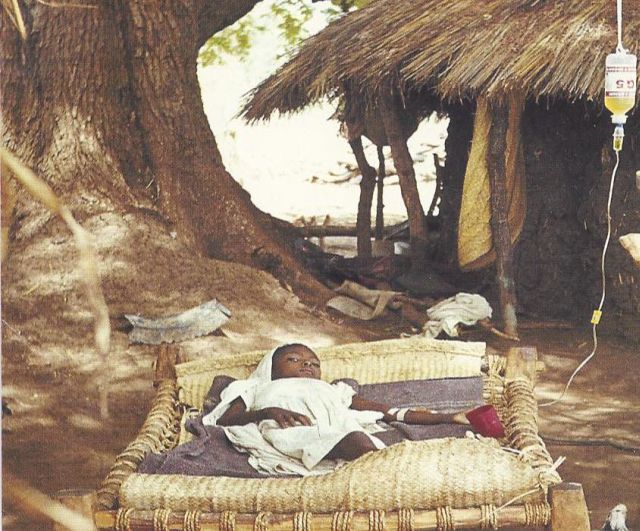
Picture 5: A child getting treatment with glucose under the shade of a tree in Yabus. Her name is Berhane; she fled to the Sudan with her parents and their neighbors who were displaced from Kusaayee, a village west of the town of Gidaami by the resettlement program of the Dergue. Berhane was only about 6 years old, but in the picture she looks like an adult because of severe malnutrition. The ORA medical staff saved the lives of many children and adults in the remote refugee settlement of Yabus.
Photo: Arfaasee Gammadaa, 1985
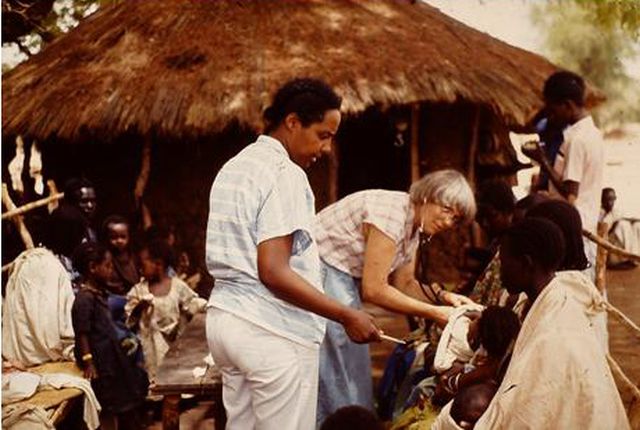
Picture 6: Members of ORA-Germany Arfaasee Gammadaa and Gerda Klein, both of them trained nurses, in Yabus in 1985.
The social backgrounds of the ORA children
As described in the first two quotations at the beginning of this article, many of the children, who were supported and educated by ORA in its children centers in Yabus, Damazin and Bikoree in the Sudan, were parentless. They lost their parents and relatives during the Dergue period. Most of them were small when they came to the ORA camps. For example, the record shows that of the 244 children who fled Yabus to Damazin, 24 percent were between six and ten years old, 67 percent were between 11 and 15, and 9 percent from 15 to 17 years old (source: ORA documents, Berlin, Germany).
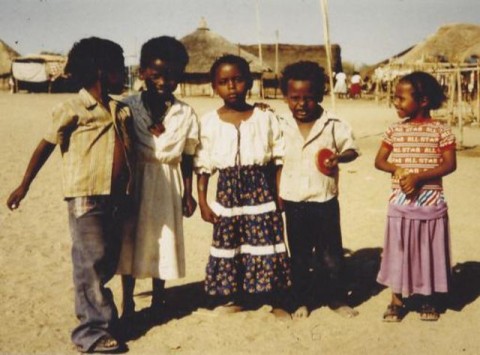
Pictures 7a & 7b: Some of the ORA children in Yabus and in Damazin in the late 1980s.
Photos: Tarfa Dibaba
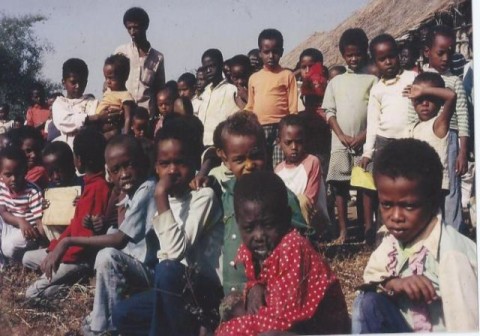
Pictures 8a & 8b: Some of the smallest ORA children in Yabus in 1988: In the forefront are the ‘inseparable sisters’ Sadiyyaa and Nuuriyya Tolasaa (see also 8b above). Many of these children were viciously killed, imprisoned and tortured by TPLF’s forces in the 1990s.
Photos: Tarfa Dibaba
The 1989 flight from Yabus
Quoting Amanda Heslop and Rachel Pounds of the London-based agency “Health Unlimited,” who were working as volunteers in Yabus as a teacher and a nurse respectively when it was attacked by the Sudan People’s Liberation Army (SPLA), the New African (April, 1990) wrote “In mid-December 1989, Oromo children started arriving in an Oromo refugee camp in Damazin, Central Sudan in a severe state of malnutrition and shock.” The New African added, “They were orphaned children who, among 6,000 Oromo refugees, had fled from the South Sudanese town of Yabus.” According to another source (Dhaabaa, November 21, 2013) some of the children were moved to Damazin and the rest were sent to Bikoree when Yabus was attacked by the SPLA. The SPLA was fighting the Sudanese army and was backed by units of the Ethiopian army when it attacked Yabus.

Picture 9: The 244 children who fled from Yabus to Damazin in December 1989 were quartered in tents on their arrival. The tents and other ORA properties, including trucks and large amounts of food in store, were confiscated by the Sudanese government in 1992 supporting the Tigrayan regime in Finfinnee (Addis Ababa)
The tents were donated by the German Ministry for Development Aid
Photo: Tarfa Dibaba
The children who were in the ORA children’s camps in the Sudan in the mid-1980s returned home in 1992. According to the ORA, the first batch of its 1033 children returned to Oromia from Bikoree in early 1992. They were joined in May 1992 by 691 children from Damazin. In addition to the 1,724 returnees from the Sudan, there were over 300 children in two camps — one in Caanqaa and the other Mummee Dhoqsaa in OLF controlled areas (source: Dhaaba as above).
Following the demise of the Dergue regime, “Those from Bikore, aged 12-18, were moved to Asosa in 1991. Because of the poor security situation there, they were moved to a site near Mendi (Wallagaa) for one year. Nearby clashes between the OLF and the TPLF forced them to be moved around April/May 1992 to Kobor, 10-20 km in the direction of Asosa from Begi” town. Soon after, “the 5-15 year olds” from Damazin also arrived in Kobor (OSG Press Release, No. 13, 1996).
“We were all full of joy to be back in our country”
Research on international migration shows that, irrespective of age, sex and profession, a spiritual and physical return to the lands of their ancestors is uppermost in the minds of most of those who find themselves outside of their homeland against their wishes. Indeed, the ORA children must have been very happy to return to their homeland. The parents of many of them had sacrificed their lives fighting for its freedom. In a letter he wrote to ORA-Germany, Raagaa, who escaped from the Dhidheessa concentration camp explained,
When the situation seemed favorable to move back to our country, arrangements were made to take us back to our home areas of western Wallagaa. … First, we were taken to Mendi and from there to Begi. We did not see anything of the fighting between the TPLF and the OLF. We did not know anything about the problem. We did not see any armed units on the way. We enjoyed a short-lived peaceful time. We continued our regular lessons under shady trees and in small village schools and spent most of the time outside enjoying the cool climate of our country. We were all full of joy to be back in our country (emphasis mine).
Raagaa belongs to the batch of children who returned from Bikoree in early 1992. The joy he described above did not last long. Those who returned from Damazin in May 1992 did not get a chance to experience even the short-lived peaceful life that the returnees from Bikoree experienced. Their dream of a happy life in a free homeland was shattered by terror perpetrated by enemy forces which occupied their homeland. The children were deprived not only the right to live and grow in freedom and happiness in their ancestral homeland, but many of them were also deprived of the right to life itself.
A walk into a death trap
The return of the ORA children from Damazin to Oromia coincided with the encampment of the OLF forces – which was mediated by representatives of the U.S. and Eritrean governments and signed by the OLF and the TPLF, preparing the ground for elections planned to take place in June 1992. But that did not happen. As we all know, following the withdrawal of the OLF from the local elections scheduled for the third week of June, its camps were attacked by the TPLF soldiers, who were not encamped like those of the OLF.
Regrettably, it was not the peace and happiness for which the children were longing, but violence, horror and death that was waiting for them at home in the shape of a new enemy that had occupied it. Ironically, from the relative security in refugee camps in the Sudan, they walked into a death trap laid out by the TPLF-led regime in their homeland. The shelters for the children at Gabaa Jimaata (for those from Bikoree) and at Ganda Qondaala (for those from Damazin) — both near Kobor — were attacked as if they too were OLF camps. So were the smaller shelters at Mummee Dhoqsaa and Caanqaa. The fact that the shelters were both homes and schools for children was known to the public. This was not hidden from the TPLF troops. They would have been informed, not only by their intelligence agents, but were in the area for weeks before they started their murderous attack on the children. In other words, the assaults on the shelters were carried out with the intent of harming the children. At that time of the attack, 1,724 children who returned from the Sudan and 22 who joined them at home (altogether 1,746 children) lived with their 37 caretakers and 35 teachers in the two ORA children centers mentioned above. In addition, the two smaller centers at Caanqaa and Mummee Dhoqsaa run by the OLF, housed and supported about 300 internally displaced, poor or parentless children. All in all, the assault targeted over 2000 children. According to Dhaabaa (November 21, 2013), at that time the children were receiving training in different skills in addition to the education given in public schools.
Describing what had happened to the children he had bravely tried to protect from the TPLF killers during their three-month long bewildering flight, Dhaaba (November 21, 2013) wrote,
“Ijoolleen mirga namummaa, kabaja ijoollummaa isaani illee utuu hinsafeeffatamin addamsuun, irratti dhukaasuun, madaa’uu fi ajjeefamun akkasumas hidhaatti guuramuun carraa isaanii tahe”
Translated into English the statement reads,
“The children were denied human rights; they were hunted, shot at, wounded and killed. Those who were captured were dragged into prison in violation of ethics that ought to be respected. That became their fate.”

Picture 10: A classroom in a school ran by ORA for refugee children in Damazin
As reflected in the eager faces of these pupils, children in refugee camps often have an amazing thirst for education. They see in it a better future. Regrettably, the life of these knowledge thirsty ORA children was cut short by the TPLF regime. They lacked protection: parental, organizational and legal.
Photo: Tarfa Dibaba, 1988
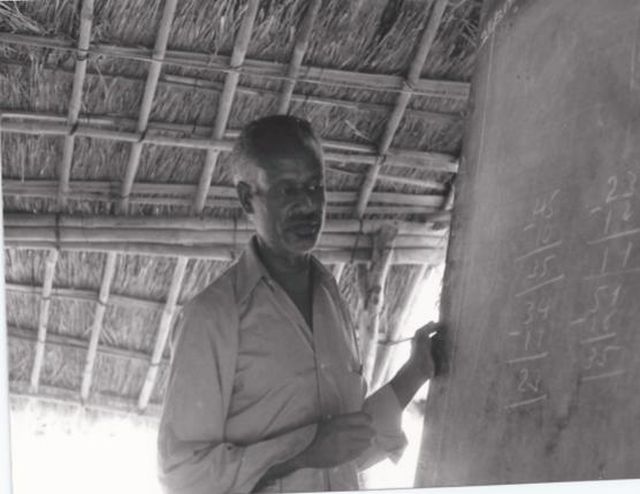
Picture 11: Obbo Shifarraa was one of the assistant teachers and caretaker of ORA children in the ORA school in Damazin
ORA and the OLF ran schools which taught classes up to grade six. This was also the case in areas under OLF control inside Oromia. It was here that together with the literacy classes that were given to Oromo refugees in different places in the Sudan, Djibouti and Somalia and elsewhere that the qubee based educational system adopted by all school Oromia in 1992 was laid down.

Picture 12: Shows a classroom in Bikoree in 1990. It is difficult to say how many of these lovely kids were killed during the June-July 1992 TPLF onslaught or died in Dhidheessa concentration camp later.
Photo: Tarfa Dibaba
Through Forests and Marshlands and Over Mountains with Killers on their Heels
Dhaba reported that they, the teachers and caretakers (hereafter the guardians), fled with the children into the Charphaa forest. From there, they sent some of the children away to Gidaami and some of them to Begi to look for relatives or hide among the local population. The TPLF forces arrived after sometime and opened fire on the group. In the shooting that followed, some of the children were killed or injured. The children and their guardians fled from Carphaa to the Gaara Arbaa mountain range. Helped with information about the whereabouts of the TPLF forces provided by the sympathetic local population, they had been hitherto ahead of their hunters. However, soon after, two days after their arrival in Gaara Arbaa area, they detected that the TPLF fighters were building a ring around the forest wherein they were hiding. The children were forced to rush down the hillsides toward the Dabus River. As the month of June is part of the season when the rainfalls are the heaviest, the valley had turned into a marshland and was covered with impenetrable tall elephant grass. Fleeing on foot through the wild and impenetrable vegetation was taxing. Blood-thirsty insects swarmed in the tall grass making travel through them immensely difficult and unbearable even to the most experienced adults: they had to fight off biting insects and struggle to walk through the grass at the same time. The children and their guardians found the Dabus was in full flood and unfordable on foot. Fortunately, there were canoes owned by the locals. However, they carried only 2 or 3 individuals at a time. Therefore, it took many hours filled with fear and anxiety to take the children to the other side. After ten days, the children and their caretakers came to Mummee Dhoqsaa on the banks of the Dillaa River, a tributary of the Dabus after ten days (Dhaabaa, December 9, 2013).
The Dillaa was also in flood and, as the children were trying to cross under similar stress and circumstances (as when they crossed the Dabus), the TPLF, whose soldiers were still on their heels, opened fire on them in the Gunfi area. According the OSG report mentioned above, an unknown number of children were killed or wounded, and some were captured by the soldiers. The rest were separated and scattered in different directions. Dhaabaa reported (December 9, 2013) that a clinic in Gunfi (where children who were suffering from malaria and other diseases were getting medication) was surrounded by the TPLF soldiers who opened fire on them. Although caretakers were assigned and had accompanied each group (Dhaabaa, see above) it is difficult to say how many of the children were able to escape the TPLF troops as they continued to chase and capture or kill them for many weeks.
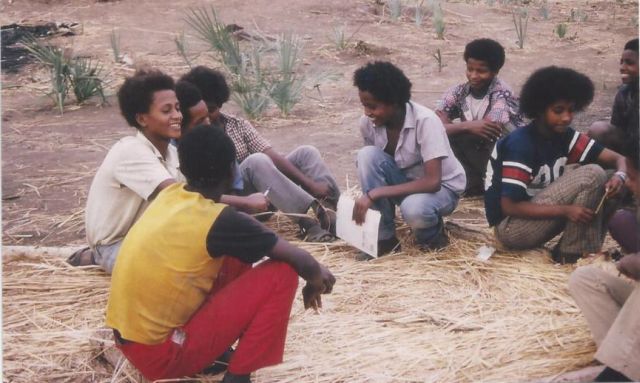
Picture 13: Some of the ORA teenagers in Bikoree, Sudan, having a good time together in 1990.
This and the other pictures taken in exile show that the children were well cared for by ORA.
Photo: Tarfa Dibaba
As mentioned above, there is no doubt that the TPLF forces knew that those who were fleeing from them were children, as well as their caretakers and teachers, and not Oromo soldiers or fighters. Although they might have been “carrying out” orders from above, they behaved monstrously as though the children they were chasing and killing were not human beings like themselves. It seems that they captured, persecuted or killed the children as a matter of duty.
Killed by TPLF bullets or taken by floods while fleeing from them
Nobody knows how many of the ORA children were killed or captured and imprisoned by the TPLF. Different incidents are mentioned by the sources in which the children incurred casualties at the initial stage of their flight. According Abdalla Suleeman, a former OLF fighter, in one attack at a place called Yaa’a Masaraa, near Kobor in Begi district, over 30 children were killed when the TPLF forces bombed a building in which the fleeing children took shelter. He also mentions that many children had also drowned when the pursuing forces opened fire on them on the banks of the Dabus River (personal communication, March 2013). One of the eyewitness-accounts of the TPLF assault was given by a 13-year-old girl, “Milkii” (fictive name as she is married and lives in Oromia now). Milkii was among the group of children who were sent in the direction of Mendi in the north. Although wounded when her group was attacked on the banks of the Dabus River, she was lucky to escape together with her 11-year brother and many of her companions. Regrettably, it was not all the children in her group who had that luck. She said that between 35 and 40 children in her cohort were killed on the riverbank or drowned while trying to cross to the other side seeking safety.
Since we do not have any other eyewitness of the incident described above, we have to accept Milkii’s account with caution. This, not because I believe she is telling lies, but because of the situation under which she had made the observation. However, it is important to note that other sources also indicate that a number of the ORA children had drowned while crossing the Dabus River or its tributaries. The OSG, for example, mentions that about 20 children had drowned while Dhaabaa mentions only one child who died in such an accident. Since the children were dispersed and fled in different directions, nobody seems to know how many of them had drowned or were killed during the flight. It is also difficult to verify whether the sources are referring to the same or to different incidents. In general, given the information we have, it is impossible to account for the fate of the majority of the 1,724 children who returned home, nor of the 300 who were in the Caanqaa and Mummee Dhoqsaa shelters when the TPLF attacked them in June 1992. However, regarding the number of children killed by the TPLFforces,the OSG (Press Release no. 13, August 1996: 17) wrote that “Between 170 and 200 bodies of children were found.” The OSG indicated that the figures were based on “Interviews with surviving children, teachers and carers, and interviews with residents in Wollega province over the last twelve months.” In short, although we cannot confirm the death statistics given above, there is no doubt that many of the ORA children were killed during their three-month long vicious pursuit and assault by the TPLF forces. Among those who were gunned down by the TPLF forces were the three boys — Tolina Waaqjiraa, Duula Tafarraa and Sagantaa Useen — mentioned in the letter cited at the beginning of the article (Dhaabaa, December 9, 2013). As mentioned above, over 300 children were captured and imprisoned in the Dhidheessa concentration camp. As will be revealed in the next part of this article, many died there from hunger, diseases and torture.
Crime against guardians and sympathetic local Oromo population
Noteworthy aspects of the flight of the ORA children were the courage that their guardians — their teachers and caretakers — had shown in protecting them as well as the support given them by the inhabitants of the districts they traversed. The price which both the guardians and many sympathetic peasants had paid to protect and support the children was high. Some were killed during the flight. It seems many were also caught and imprisoned. Among the children’s guardians who were killed were Abbaa Jambaree and Adabaa Imaanaa. The killing of the physically handicapped Adabaa Imaanaa was carried out with barbaric brutality. Dhabaa wrote (November 21, 2013) that:
Adabaa Imaanaa was a guardian of the ORA children starting in Bikoree until the time of the TPLF assault. As he couldn’t walk, I got help from the people who gave us a mule to be used by him during flight from the assaulters. We were followed by the enemy from place to place and arrived in Mummee Dhoksaa on the banks of the Dillaa Gogolaa. After sometime we were surrounded by the enemy. They opened gunfire on us. One of the children’s caretakers, Abba Jambaree was killed. We managed to cross the river by canoes. Since his mule was frightened by the gunfire, panicked and galloped away, we sent away Adaba Imaanaa to limp to his village hiding from the enemy. When I went to his village later and I heard from his neighbors that he had reached his village with difficulty. But the TPLF agents had traced him, surrounded his house, took him out and killed him in late 1992.
However, in spite of the risks involved, the Oromo inhabitants of the districts through which the children passed, sheltered, fed, and directed them to the safest routes, informing them about the whereabouts of the TPLF forces. They had also volunteered to receive and hide those children whom the ORA staff were forced to place in their guardianship. The generosity shown to the fleeing children and their guardians by the inhabitants of the many villages through which they passed, did not go unpunished by the TPLF. According Dhaabaa (November 21, 2013), the first person to be accused of helping the ORA children was a priest in the village of Gabaa Jimaata mentioned above. His name was Abbabaa. He was dragged out of his house by the TPLF soldiers and shot in cold blood. A farmer called Gaaddisaa Daaphoo was killed for feeding the children and their guardians in Harrojjii, a village in which they stayed during their flight.
It is difficult to imagine the hate that makes people commit such atrocities. Why did they kill, for example, a physically handicapped old man? Is it because he was an Oromo? What did the Oromo do to them? How can one hate a people amongst whom one lives in such a manner? Some probable answers to these questions will be discussed in the forthcoming part of this article.
———————
[i] Politicide means “a crime committed with intention on political grounds.” More fully, it is a deliberate killing or physical destruction of a group who form (or whose members share a distinctive characteristic of) a political movement.
[ii] I was a contributor for a short time before I left Ethiopia in September 1977.
[iii] See for example, Virginia Lulling, “Oromo Refugees in a Sudanese Town”, Journal of Northeast African Studies, 8(2&3), 1996.
———————
* Mekuria Bulcha, PhD and Professor of Sociology, is an author of widely read books and articles. His most recent book, Contours of the Emergent and Ancient Oromo Nation, was published by CASAS (Centre for Advanced Studies of African Society), Cape Town, South Africa, in 2011. He was also the founder and publisher of The Oromo Commentary (1990-1999). He is an active member of the OLF and has served in the different branches of the national movement since the 1970s.
